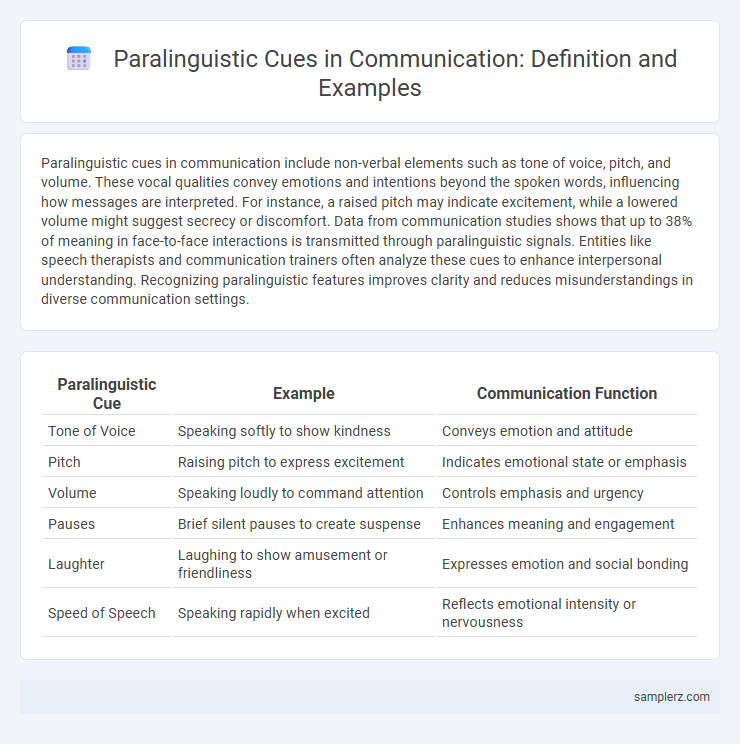Paralinguistic cues in communication include non-verbal elements such as tone of voice, pitch, and volume. These vocal qualities convey emotions and intentions beyond the spoken words, influencing how messages are interpreted. For instance, a raised pitch may indicate excitement, while a lowered volume might suggest secrecy or discomfort. Data from communication studies shows that up to 38% of meaning in face-to-face interactions is transmitted through paralinguistic signals. Entities like speech therapists and communication trainers often analyze these cues to enhance interpersonal understanding. Recognizing paralinguistic features improves clarity and reduces misunderstandings in diverse communication settings.
Table of Comparison
| Paralinguistic Cue | Example | Communication Function |
|---|---|---|
| Tone of Voice | Speaking softly to show kindness | Conveys emotion and attitude |
| Pitch | Raising pitch to express excitement | Indicates emotional state or emphasis |
| Volume | Speaking loudly to command attention | Controls emphasis and urgency |
| Pauses | Brief silent pauses to create suspense | Enhances meaning and engagement |
| Laughter | Laughing to show amusement or friendliness | Expresses emotion and social bonding |
| Speed of Speech | Speaking rapidly when excited | Reflects emotional intensity or nervousness |
Introduction to Paralinguistic Cues in Communication
Paralinguistic cues in communication include non-verbal elements such as tone of voice, pitch, and speech rate that convey meaning beyond words. These vocal nuances help express emotions, attitudes, and emphasize key points during interactions. Understanding paralinguistic cues enhances effective communication by interpreting the speaker's underlying feelings and intentions.
Tone of Voice: Conveying Emotions Beyond Words
Tone of voice serves as a powerful paralinguistic cue that conveys emotions such as anger, happiness, or sarcasm beyond the literal meaning of words. Variations in pitch, volume, and speed enable listeners to interpret the speaker's true feelings and intentions, enhancing understanding in interpersonal communication. Effective use of tone of voice can prevent misunderstandings and foster emotional connection between communicators.
Volume and Pitch: Emphasizing Meaning in Speech
Volume and pitch are crucial paralinguistic cues that shape how messages are received in communication. Increasing volume can convey urgency or anger, while lowering it may indicate intimacy or secrecy. Variations in pitch help emphasize key points, reveal emotions, and engage listeners more effectively.
Speech Rate: Influence on Message Perception
Speech rate, a key paralinguistic cue, significantly influences how a message is perceived by listeners. Faster speech can convey urgency or excitement but may reduce comprehension, while slower speech often signals seriousness and allows for better understanding. Effective communicators adjust their speech rate to match the context and audience, enhancing message clarity and engagement.
Pausing and Silence: Power in Nonverbal Expression
Pausing and silence serve as powerful paralinguistic cues in communication, enhancing message clarity and emotional impact without words. Strategic pauses can emphasize key points, signal turn-taking, or create suspense, while silence often conveys contemplation, discomfort, or respect. These nonverbal expressions influence conversational dynamics by shaping listener perception and reinforcing speaker intent.
Laughter and Sighs: Emotional Signals in Conversation
Laughter in communication often conveys amusement, relief, or social bonding, acting as a paralinguistic cue that enhances emotional connection without words. Sighs serve as powerful emotional signals indicating tiredness, frustration, or resignation, providing insight into a speaker's internal state beyond verbal content. Both laughter and sighs enrich conversational dynamics by revealing unspoken feelings and intentions.
Intonation Patterns: Shaping Listener Interpretation
Intonation patterns in communication significantly influence listener interpretation by conveying emotions, emphasis, and intent beyond spoken words. Rising intonation at the end of a sentence often indicates a question or uncertainty, while falling intonation typically signals certainty or completion. Variations in pitch, tone, and rhythm serve as critical paralinguistic cues that shape how messages are understood and responded to in conversations.
Stress and Emphasis: Highlighting Key Information
Stress and emphasis in paralinguistic communication involve varying pitch, loudness, and duration to highlight key information within a message. For example, raising vocal pitch or elongating a syllable can signal the importance of a word, guiding listeners' attention to critical points. These vocal nuances enhance message clarity and emotional impact, making communication more effective.
Vocal Fillers: Impact on Communication Flow
Vocal fillers such as "um," "uh," and "like" serve as paralinguistic cues that signal hesitation or thought processing during speech. Frequent use of vocal fillers can disrupt the communication flow, causing listeners to perceive uncertainty or reduce message clarity. Effective communication benefits from minimizing vocal fillers to maintain speaker confidence and enhance listener engagement.
Cultural Differences in Paralinguistic Cues
Paralinguistic cues such as tone of voice, pitch, and volume carry varied meanings across cultures, influencing the interpretation of messages during communication. For example, a loud voice may signify enthusiasm in Mediterranean cultures but be considered aggressive in East Asian contexts. Understanding these cultural differences in paralinguistic cues is crucial for effective cross-cultural communication and avoiding misunderstandings.

example of paralinguistic cue in communication Infographic
 samplerz.com
samplerz.com